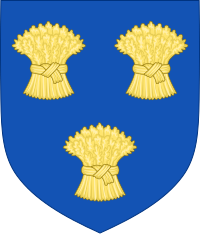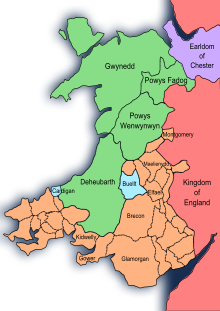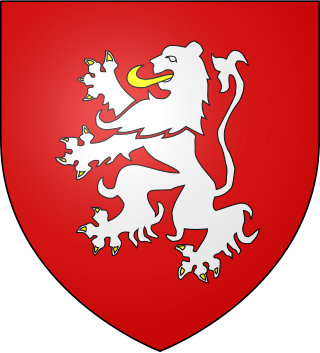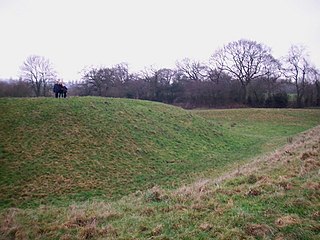| Earl of Chester (1st creation), 1067–1070 |
|
Gerbod the Fleming
(?)
Earl of Chester | | Richard Goz
(d. after 1082) | | | | | | King William I
(c. 1028–1087) |
|
| Earldom of Chester (1st creation) forfeit, 1071 | | | | | | | | | | | | | | | |
| | | | |
| | | | | | | | | Earl of Chester (2nd creation), 1071 | | | | | | | | | | | | | |
| | | | | | | | |
| | | | Maud (Margaret) | | Hugh d'Avranches
(c. 1047–1101)
1st Earl of Chester | | Adela of Normandy
(c. 1067–1137) | | Stephen, Count of Blois
(c. 1045–1102) | | King Henry I
(c. 1068–1135) |
| |
| | | | | | | | | | | | | | | | | | | | | | | | | | | |
| | | | | | | | | |
| | | | Ranulf le Meschin
(1070–1129)
3rd Earl of Chester | | Richard d'Avranches
(1094–1120)
2nd Earl of Chester | | Lucia-Mahaut
(d. 1120) | | Robert Rufus
(c. 1090–1147)
1st Earl of Gloucester |
|
| | | | | | | | | | | | | | | | | | | | | |
| | | | | | | | | |
| | | | Ranulf de Gernon
(1099–1153)
4th Earl of Chester | | Maud (Matilda) of Gloucester
(d. 1189) |
| |
| | | | | | | | | | | | | | | | |
| | | |
| | | | Hugh of Cyfeiliog
(1147–1181)
5th Earl of Chester |
|
| | | | | | | | | | | | | | | | |
| | | | |
| | | | Ranulf de Blondeville
(1170–1232)
6th Earl of Chester
Earl of Lincoln | | Matilda (Maud)
(1171–1233)
Countess of Chester suo jure |
|
| | | | | | | | | | | | | | | | | EARL OF CHESTER (4th reation), 1264 |
|
| | | | | | | | John of Scotland
(c. 1207–1237)
7th Earl of Chester
Earl of Huntingdon | | | | | | Simon de Montfort
(1208–1265)
Earl of Chester
Earl of Leicester |
|
| | | | | | | | Earldom of Chester (2nd creation) reverted to the crown, 1237 | | EARL OF CHESTER (3rd creation), 1254 | | Earldom of Chester (4th creation) forfeit, 1265 |
|
| | | | | | | | | | | | Edward, Lord of Chester
(1239–1307)
Earl of Chester (without the title of Earl)
later King Edward I |
|
| | | | | | | | | | | | Earldom of Chester (3rd creation) reverted to the crown, 1272 |
|
| | | | | | | | | | | | | | | |
|
| | | | | | | | | | | | EARL OF CHESTER (5th creation), 1301 |
|
| | | | | | | | | | | | Edward of Caernarfon
(1284–1327)
Prince of Wales and Earl of Chester
1301–1307
later King Edward II |
|
| | | | | | | | | | | | Earldom of Chester (5th creation) reverted to the crown, 1307 |
|
| | | | | | | | | | | | | | | |
|
| | | | | | | | | | | | EARL OF CHESTER (6th creation), 1312 |
|
Robert Stewart
(1316–1390)
Earl of Carrick (1316–1368)
later King Robert II of Scots | | | | | | | | | | Edward Plantagenet
(1312–1377)
Earl of Chester (1312–1327)
later King Edward III |
|
| | | | | | | | | | | | | Hereafter, the Earldom of Chester was created in conjunction with the Principality of Wales. |
|
| | | | | | | | | | | | | | | | | | | | | | | | | | |
| | | | | | | | | | | | | | | | | | | |
| | | | | DUKE OF CORNWALL, 1337 | | | | | | | | | | | | | | | | | | | |
|
John Stewart
(1337–1406)
Earl of Carrick (1368–1390)
later King Robert III of Scots | | Edward the Black Prince
(1330–1376)
Duke of Cornwall (1337–1376)
Prince of Wales (1343–1376) | | John of Gaunt
(1340–1399)
Duke of Lancaster | | | | | | Lionel of Antwerp
(1338–1368)
Duke of Clarence | | Edmund of Langley
(1341–1402)
Duke of York |
|
| | | | | Dukedom of Cornwall extinct, 1376 | | | | | | | | | | | | | | | | | | | |
|
| | | | | | | | | | | | | | | | | | | | | | | | | | | |
|
| | | | | DUKE OF CORNWALL, 1376 | | | | | | | | | | | | | | | | | | | | |
| | | | |
| | | | | Richard of Bordeaux
(1367–1400)
Prince of Wales (1376–1377)
Duke of Cornwall (1376–1377)
later King Richard II | | John Beaufort
(c. 1371–1410) | | King Henry IV
(1366–1413) | | Philippa of Clarence
(1355–1382) | | | | | |
|
| | | | | Dukedom of Cornwall merged in the Crown, 1377 | | | | | | | | | | | | | | | | | | | | |
|
| | | | | | | | | | | | | | | | | | | | Roger Mortimer
(1374–1398) | | | | | |
| | | | |
| | | | | DUKE OF ROTHESAY created, 1398 | | | | | | | DUKE OF CORNWALL restored, 1399 | | | | | | | | | | |
|
| | | | | David Stewart
(1378–1402)
Earl of Carrick (1390–1402)
Duke of Rothesay (1398–1402) | | | | | | | Henry of Monmouth
(1386–1422)
Prince of Wales (1399–1413)
Duke of Cornwall (1399–1413)
later King Henry V | | Anne de Mortimer
(1390–1411) | | Richard of Conisburgh
(c. 1375–1415)
Earl of Cambridge |
| |
| | | | | | | | | | | | | | | | | | | | | | | | | |
| | | |
| | | | | | | | | | | | | | | | | | | | DUKE OF CORNWALL, 1460 |
| | | | | |
James
(1394–1437)
Earl of Carrick (1402–1406)
Duke of Rothesay (1404–1406)
later King James I of Scots | | Joan Beaufort
(c. 1404–1445) | | John Beaufort
(1404–1444)
Duke of Somerset | | Henry
(1421–1471)
Duke of Cornwall (1421–1422)
later King Henry VI | | Richard Plantagenet
(1411–1460)
Duke of York
Prince of Wales (1460)
Duke of Cornwall
(1460) |
| |
| | | | | | | | | | | | | | | | | | | | | | | | | | | | | |
| | | | | | | | | | |
Alexander Stewart
(1430)
Duke of Rothesay (1430) | | James
(1430–1460)
Duke of Rothesay (1431–1437)
later King James II of Scots | | Margaret Beaufort
(1443–1509) | | | | | | | King Edward IV
(1442–1483) | | King Richard III
(1452–1485) |
|
| | | | | | | | | | | | | | | | | | | | | | | | | | | | |
| | | | | |
James
(1451–1488)
Duke of Rothesay (1452–1460)
later King James III of Scots | | | | | | King Henry VII
(1457–1509) | | Edward of Westminster
(1453–1471)
Prince of Wales (1454–1471)
Duke of Cornwall (1454–1471) | | | | | | | | | | |
|
| From the 1469 Act of Scottish Parliament, the Earldom of Carrick and the Dukedom of Rothesay was to be automatically held by the "first-born Prince of the King of Scots." | | | | | | | | | | | | | | | | | | | | | | | |
|
| | | | | | | | | | | | | | | | | | | | | | | | | | | | |
| | | | | | | | | | |
James
(1473–1513)
Duke of Rothesay (1473–1488)
later King James IV of Scots | | Margaret Tudor
(1489–1541) | | Arthur Tudor
(1486–1502)
Prince of Wales (1489–1502)
Duke of Cornwall (1486–1502) | | Henry Tudor
(1491–1547)
Prince of Wales (1504–1509)
Duke of Cornwall (1502–1509)
later King Henry VIII | | Edward
(1470–1483)
Prince of Wales (1471–1483)
Duke of Cornwall (1471–1483)
later King Edward V | | Edward of Middleham
(c. 1473–1484)
Prince of Wales (1483–1484)
Duke of Cornwall (1483–1484) |
| |
| | | | | | | | | | | | | | | | | | | | | | |
| | | | | | | | | | | | | | | |
James Stewart
(1507–1508)
Duke of Rothesay (1507–1508) | | Arthur Stewart
(1509–1510)
Duke of Rothesay (1509–1510) | | James
(1512–1542)
Duke of Rothesay (1512–1513)
later King James V of Scots | | Henry
(1511)
Duke of Cornwall (1511) | | Edward Tudor
(1537–1553)
Prince of Wales (1537–1547)
Duke of Cornwall (1537–1547)
later King Edward VI |
|
| | | | | | | | | | | | |
| | | | | |
| | | | James Stewart
(1540–1541)
Duke of Rothesay (1540–1541) | | Mary, Queen of Scots
(1542–1587) |
|
| | | | | | | | | | | |
|
| | | | | | | | James Charles Stuart
(1566–1625)
Duke of Rothesay (1566–1567)
later King James VI/I |
|
| | | | | | | | | | | | |
| | | | | | | | | | |
Henry Frederick Stuart
(1594–1612)
Prince of Wales (1610–1612)
Duke of Cornwall (1603–1612)
Duke of Rothesay (1594–1612) | | Elizabeth Stuart
(1596–1662) | | Charles Stuart
(1600–1649)
Prince of Wales (1616–1625)
Duke of Cornwall (1612–1625)
Duke of Rothesay (1612–1625)
later King Charles I |
|
| | | | | | | | | | | | | | | | | | | | | |
| | | | | | | | | |
| | | | Sophia of Hanover
(1630–1714) | | Charles James
(1629)
Duke of Cornwall (1629)
Duke of Rothesay (1629)
styled Prince of Wales | | Charles Stuart
(1630–1685)
Prince of Wales (c. 1638/1641–1649)
Duke of Cornwall (1630–1649)
Duke of Rothesay (1630–1649)
later King Charles II | | King James II/VII
(1633–1701) |
|
| | | | | | | | | | | | | | | | | | | | |
|
| | | | King George I
(1660–1727) | | | | | | | | | | | | | |
|
| | | | | | | | | | | | | | | | | | | | |
|
| | | | George Augustus
(1683–1760)
Prince of Wales (1714–1727)
Duke of Cornwall (1714–1727)
Duke of Rothesay (1714–1727)
later King George II | | | | | | | | | | James Francis Edward Stuart
(1688–1766)
Prince of Wales (c. 1688–1688)
Duke of Cornwall (1688–1702)
Duke of Rothesay (1688–1702) |
|
| | | | | | | |
|
| | | | Frederick Louis
(1707–1751)
Prince of Wales (1728–1751)
Duke of Cornwall (1727–1751)
Duke of Rothesay (1727–1751) |
|
| | | | | | | |
|
| | | | George William Frederick
(1738–1820)
Prince of Wales (1751–1760)
later King George III |
|
| | | | | | | | | | | | |
| | | | |
| | | | George Augustus Frederick
(1762–1830)
Prince of Wales (1762–1820)
Duke of Cornwall (1762–1820)
Duke of Rothesay (1762–1820)
later King George IV | | Edward Augustus
(1767–1820)
Duke of Kent and Strathearn |
|
| | | | | | | | | | | |
|
| | | | | | | | Queen Victoria
(1819–1901) |
|
| | | | | | | | | | | |
|
| | | | | | | | Albert Edward
(1841–1910)
Prince of Wales (1841–1901)
Duke of Cornwall (1841–1901)
Duke of Rothesay (1841–1901)
later King Edward VII |
|
| | | | | | | | | | | |
|
| | | | | | | | George Frederick Ernest Albert
(1865–1936)
Prince of Wales (1901–1910)
Duke of Cornwall (1901–1910)
Duke of Rothesay (1901–1910)
later King George V |
|
| | | | | | | | | | | | | | | | |
| | | | |
| | | | | | | | Edward Albert Christian George Andrew Patrick David
(1894–1972)
Prince of Wales (1910–1936)
Duke of Cornwall (1910–1936)
Duke of Rothesay (1910–1936)
later King Edward VIII
later Duke of Windsor | | King George VI
(1895–1952) |
|
| | | | | | | | | | | | | | | |
|
| | | | | | | | | | | | Queen Elizabeth II
(1926–2022) |
|
| | | | | | | | | | | | | | | |
|
| | | | | | | | | | | | Charles Philip Arthur George
(b. 1948)
Prince of Wales (1958–2022)
Duke of Cornwall (1952–2022)
Duke of Rothesay (1952–2022)
later King Charles III |
|
| | | | | | | | | | | | | | | |
|
| | | | | | | | | | | | William Arthur Philip Louis
(b. 1982)
Prince of Wales (since 2022)
Duke of Cornwall (since 2022)
Duke of Rothesay (since 2022)
Duke of Cambridge |
|
| | | | | | | | | | | | | | | |
|
| | | | | | | | | | | | Prince George of Wales
(b. 2013) |
|












